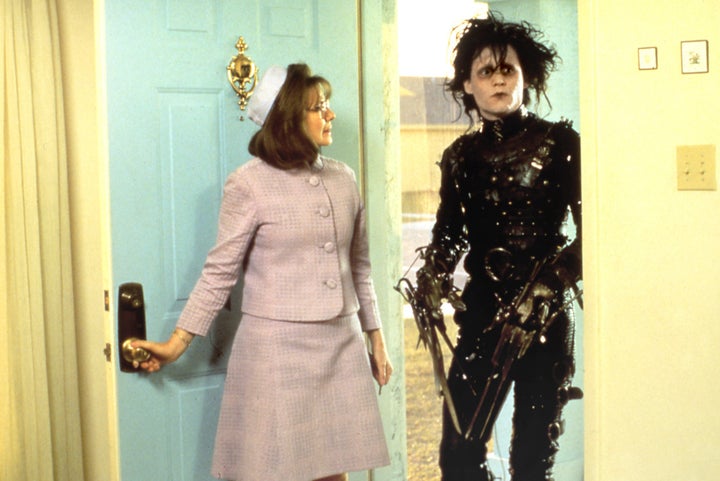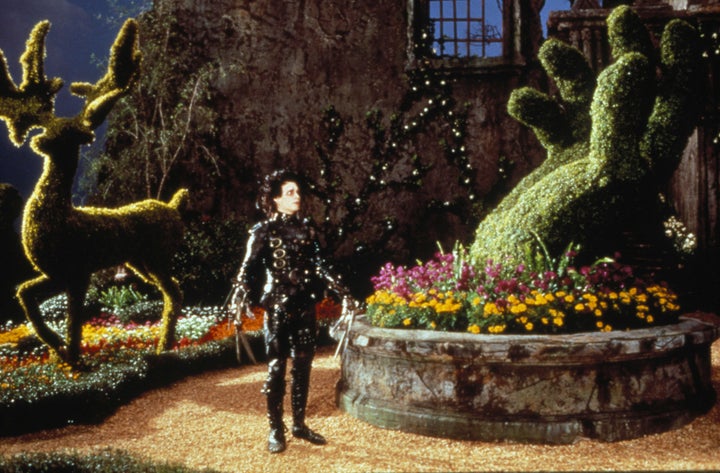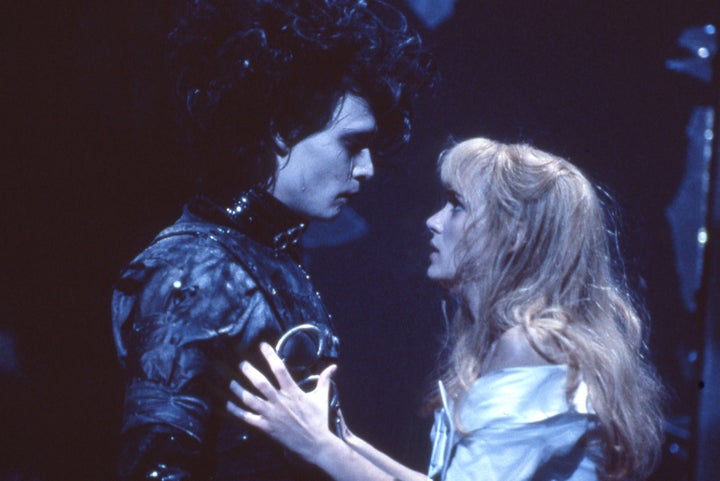
"Edward Scissorhands" is one of those rare movies that sucks you in any time it's on TV. It only takes a few minutes to get wrapped up in its titular character's gothic origins, the pastel uniformity of suburbia and the love story that envelops the film's third act. That's partly because "Scissorhands" is what crystallized Tim Burton's aesthetic. The director was coming off the success of "Beetlejuice" and "Batman" when Fox fast-tracked the movie, which became a critical and commercial success, cemented Johnny Depp's fame and earned an Oscar nomination for Best Makeup.
Twenty-five years later, "Edward Scissorhands" is being re-released via restored, special-edition Blu-ray. To mark the occasion, The Huffington Post hopped on the phone with screenwriter Caroline Thompson and production designer Bo Welch to reflect on how the story came to life. Below are highlights from the conversations, including how Edward's topiaries were created and why the movie couldn't have been made today.
On crafting the story:
Thompson: "Tim had just done 'Pee-wee’s Big Adventure' and I had written a novel that was sort of an angrier, more adolescent precursor -- a 'Frankenstein'-style story -- to 'Edward Scissorhands,' and we were represented by the same agency. The agents didn’t know what to do with him and they didn’t know what to do with me, so they introduced us. We had lunch together and we immediately felt a bond and became very good friends. Tim told me about a drawing he had made in high school of a character who had scissors instead of hands and I said, 'Stop right now. I kind of know exactly what to do with that.' And three weeks later, I gave him a 70-page prose treatment version of what actually was very close to the movie that we made."
Welch: "The thing that guided me the most was wanting to see the suburban neighborhood and the other visuals within that world as if you’re looking through Edward’s eyes. Everything had to be slightly tweaked in order to fulfill that, so through his eyes this looks ironic, but it’s also weirdly beautiful and appealing for a guy who lives in the attic of a castle with a hole in the roof and he’s tucked into the fireplace. The colors and the activity and the warmth of this neighborhood is appealing to him. We recognized it as a suburban icon."
On adding to Tim Burton's aesthetic:
Thompson: "The neighborhood was based on a neighborhood I wished I had lived in when I was a young teenager in Maryland, which is to say that my friend lived in a neighborhood where all the houses were in a brand-new development and there was very little vegetation. Mine had all old people and no kids, and she lived in this neighborhood where everybody turned up in the streets after school to play football and all the parents came out and put out chairs and watched. She grew up in this community and I grew up in this cocktail-hour joint. The trajectory of the story is that [Edward] goes to this neighborhood that, to him, is just beautiful and enchanting and delicious. They adore him at first and then when he isn’t exactly who they want him to be, as none of us is, they turn on him. So I wanted to base his neighborhood on as delightful a neighborhood as I could possibly evoke, and that was the delightful one in my life. That being said, Tim has a beautiful eye and Bo Welch’s contribution and [costume designer Colleen Atwood’s] contribution and the whole art department -- what was amazing about the making of that movie was that we were all making the same movie, and I don’t know if you know how rare that is, but it is ridiculously rare."
Welch: "I had done 'Beetlejuice' with Tim, which was a learning experience for me, so by the time I did 'Edward Scissorhands' with Tim, I totally got his aesthetic. I’m there basically to serve his vision of the film. Tim draws very well, so mainly he’d draw characters. I remember, early on, looking at the drawing of Edward Scissorhands that he had done, and like all of his drawings, it ended up looking just like the character looks in the film, more or less. I looked at those as my cue on where to go design-wise, but in reading the script, I’d read about where Edward lives and where he comes from and his adjacency to a model suburban neighborhood. And I asked, 'So these two things that are so different are going to coexist in the same film?' And Tim goes, 'Yes!' First I designed where Edward lives, and then we scouted neighborhoods, by photographs, all over the U.S. looking for new suburbs. We landed on Florida because it just looked more graphic and it had interesting skies. Those two elements, I think, create kind of a friction next to one another. That’s the magic of that."

On the complications of shooting in a real neighborhood:
Welch: "We went door-to-door and got them all to agree to allowing us to cut out all of their shrubs and paint their houses. In some places, we’d put up false fronts to make windows smaller and to make them more uniform. The people were paid money for the use of their yard, and if they wanted to be put up in Disney World or something they could do that during the shoot. It’s quite an achievement in terms of location management to do that. It was about 20 houses and we had every one except one house in the center, and they were holding out for more money. They said, 'Nope, can’t do ours.' We didn’t know what to do, so we basically said, 'Let’s just go ahead and do it and we’ll shoot around it, even though it’s dead center in the neighborhood.' We treated all the houses, painted all of them, did the shrubs and the topiary to every house but theirs, and they eventually realized that we’re just going to do it regardless, so they caved in, too. Thank God they did because then we would have been hamstrung by that one odd man out in the center of the neighborhood."
On writing Edward:
Thompson: "I based the character of Edward Scissorhands on a combination of my dog and Tim. It was a love letter to Tim, really. The character was based on a dog that I had who was so ridiculously present that if she had had the physiological ability I swear she could have talked. And if you examine Edward, that’s what he’s like. He’s this dog that’s like, 'What do you need? Here I am.' Somebody once counted the number of words that he says in the script and I can’t recall it precisely, but I think it’s something south of 150 words. He’s basically a nonverbal character. He’s a beautiful, wild-eyed dog. Johnny nailed my dog."

On Edward's shrubbery creations:
Welch: "We designed them in the art department. We said, 'Okay, how about one is a dinosaur and one is a tutle and whatever?' They tended to be fantastical animals. We designed them and then had them manufactured. They’re light-weight steel armitures wrapped with chicken wire and stuffed with artificial greens. They were light enough to move around."
On why the movie wouldn't be made today:
Thompson: "Here’s the amazing thing about the deal that we made: Scott Rudin was the head of Fox at the time, which was in the mid-‘80s. He recognized in Tim a talent unlike any other talent and basically I think he would have made the phone book if Tim had wanted to make the phone book. So Tim said, 'Here’s the deal: no notes, no meetings, no nothing. We turn it in on a Friday, you tell us on a Monday if you’re making it.' That’s literally the only way this movie could have been made then and it never would have been made now. It just doesn’t stand up to the kind of micromanagement scrutiny that executives bring to bear on every script they get their hands on. You couldn’t have answered the question 'How did Edward go to the bathroom?' for example. It’s just not a question to be asked or answered, but they would have put a nail gun to my head to get an answer. But when people want to make a contribution to something, mostly they bring logic to it, and that’s their job. So our agents said, 'Let’s just not have that job exist.' I wrote the script in ’86 and Tim, in the meantime, was working on 'Beetlejuice.' The whole business is so much more corporate now. I would hope I’m wrong, but I don’t think you could ever make a deal that says 'no notes, no meetings' today."
"Edward Scissorhands" is now available on Blu-ray. The above quotes have been condensed.
Also on HuffPost:


